The Saint Andrew’s Church is one of five so-called monumental churches in Antwerp. The church was built in the sixteenth century in a late-Gothic style but the interior is mostly Baroque.
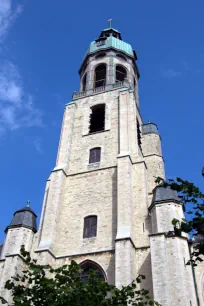
The church was built for the Augustine friars who arrived in Antwerp in 1513 and settled in the Quarter of St. Andrew’s, a neighborhood that for centuries was one of the poorest in the city; even today it is still commonly known as the ‘parish of misery’. The church was designed in a Gothic style by Domien de Waghemakere, a master builder most famous for creating the flamboyant spire of the Cathedral of our Lady.
In 1522 the Augustinians were banished by Emperor Charles V for their sympathies with Lutheranism (Martin Luther was an Augustinian friar). The monastery was demolished, but nevertheless construction on the church continued due to Archduchess Margaret of Austria’s decision to transform the monastic church into a parish church. She also decided to dedicate it to the apostle Andrew. The church was consecrated in 1529.
The church was further expanded in 1555-1560, when the side aisles were added. The distinctive tower is of a much more recent date: it was built in 1763 and was completely reconstructed as recent as in 1977 after it had fallen into disrepair.
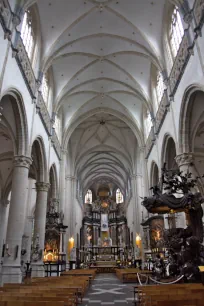
Interior
Aside from the octagonal domed bell tower and the statue of St. Andrew over the main porch, the exterior of the St. Andrew’s Church is pretty unremarkable.
More interesting is the interior, which features predominantly Baroque artwork. All the original Renaissance and Gothic art was destroyed during the Iconoclastic Furies (1566, 1581) and the Calvinist regime of 1577-1585. Starting with the Counter-Reformation, the church was embellished once again with new and recycled works of art. New decorations are still being added to this day, and the church boasts some 21st century artwork, including a painting by Alain Senez and a gown for the statue of the Virgin Mary on the Lady Altar, designed in 2001 by Ann Demeulemeester.
Highlights
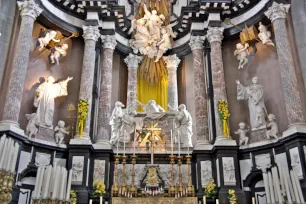
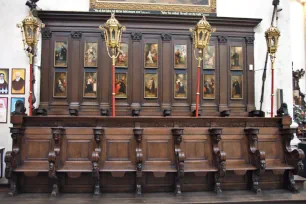
But the main highlights inside are from the seventeenth and eighteenth centuries. The church’s pièce de résistance is the magnificent high altar, a Baroque masterpiece created in 1665 by Peter Verbruggen. The massive altar, with marble Corinthian pillars and numerous statues, was originally created for an abbey church in Hemiksem. In 1807, after the abbey was closed by the Napoleonic regime, its altar was moved to the St. Andrew’s church, where it occupies the whole width of the chancel.
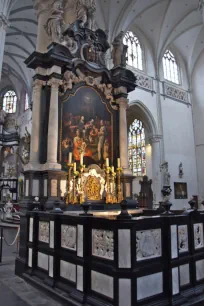
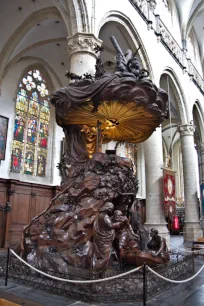

The choir benches with Baroque wood carvings were also created by Peter Verbruggen. They originate from another Augustine monastery in the Kammenstraat and date fom the seventeenth century. In the panels above the benches are thirty-six portraits of saints that were painted in the mid-seventeenth century by Theodoor Boeyermans for yet another abbey church. They were transferred to the St. Andrew’s Church in 1802. The relics of all those saints are housed in a magnificent shrine that is supported by three angels. Also in the choir is a painting that depicts the martyrdom of St. Andrew. It is a work from 1599 by Otto van Veen, a teacher of Rubens.
There are two nave altars near the crossing, between the nave and the aisles. They were created in 1664 – 1674 and feature altarpieces created by the Flemish Baroque painters Maarten Pepijn and Frans II Francken. A more unusual altar, the Altar of the Minters, can be found in the north transept. It was originally placed here in 1529 by the guild of the minters, who worked in the nearby mint. This altar, which was dedicated to saint Eloy, the patron saint of metalworkers, was destroyed during the Iconoclastic fury, but recreated in 1589. Only the altar’s 1601 triptych has survived, but the altar was reconstructed in 2001 on the occasion of the introduction of the euro, hence it is now also known as the Euro-altar. The panels on the altarpiece depict biblical references to money.
The most eye-catching sight in the church is the spectacular wood carved pulpit, created in 1821 by a duo of Flemish sculptors, Jan-Baptist van Hool and Frans Van Geel. The dynamic work with expressive life-size figures captures the moment the fishermen Andrew and Peter meet Jesus and become his disciples. The brothers are depicted in a small boat, complete with oars and fishing nets.
There are a number of interesting monuments in the church, the most important of which is the Memorial to Mary Stuart, Queen of Scots. After Mary Stuart was executed for her attempt to reinstitute Catholicism in England, two of her ladies-in-waiting fled to Antwerp. Both women were later buried in the church. The memorial was created in 1620, shortly after their death, and shows a portrait of Mary Stuart along with statues of the saints Barbara and Elisabeth and, at the top, of Mary and Child.
The church also boasts colorful Neo-Gothic windows from the nineteenth century. A number of these stained-glass windows were destroyed by a V-bomb that landed on the Vrijdagmarkt on January 2, 1945, near the end of the Second World War. They were replaced during the 1960s by modern windows.
- Next: Felix Pakhuis
- More Sights & Attractions in Antwerp

